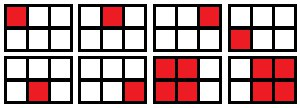Spongebob is already tired trying to reason his weird actions and calculations, so he simply asked you to find all pairs of n and m, such that there are exactly x distinct squares in the table consisting of n rows and m columns. For example, in a 3 × 5 table there are 15 squares with side one, 8 squares with side two and 3 squares with side three. The total number of distinct squares in a 3 × 5 table is15 + 8 + 3 = 26.
The first line of the input contains a single integer x (1 ≤ x ≤ 1018) — the number of squares inside the tables Spongebob is interested in.
First print a single integer k — the number of tables with exactly x distinct squares inside.
Then print k pairs of integers describing the tables. Print the pairs in the order of increasing n, and in case of equality — in the order of increasing m.
26
6 1 26 2 9 3 5 5 3 9 2 26 1
2
2 1 2 2 1
8
4 1 8 2 3 3 2 8 1
In a 1 × 2 table there are 2 1 × 1 squares. So, 2 distinct squares in total.

In a 2 × 3 table there are 6 1 × 1 squares and 2 2 × 2 squares. That is equal to 8 squares in total.

把③化简得到 :6*x = 6*n*n*m - 3*(n+m)*n*(n-1) + n*(n-1)*(2*n-1)
进而有 (3*n*n+3*n)*m = 6*x + n*n*n - n
枚举n求m即可
#include<cstdio>
#include<cstring>
#include<cmath>
#include<algorithm>
#include<vector>
typedef long long ll;
using namespace std;
struct Node{
ll nn,mm;
};
vector<Node>ans;
ll high=5000000;
int main()
{
ll x;
scanf("%I64d",&x);
for(ll n=1;n<=high;n++){ //枚举n
ll a=6*x+n*n*n-n;
ll b=3*n*n+3*n;
if(a%b!=0)continue;
ll m=a/b;
if(n>m)break; //枚举到n<=m即可,因为在n>m时的结果等于n<m所有结果(n,m)的交换,即(m,n)
Node now;
now.nn=n;
now.mm=m;
ans.push_back(now);
}
int top=ans.size()-1;
//如果最末答案为(n,n),则总数为2*(n<=m的对数)-1,否则总数为2*(n<=m的对数)
if(ans[top].nn==ans[top].mm) top=ans.size()*2-1;
else top=ans.size()*2;
printf("%d\n",top);
int i;
top=ans.size()-1;
for(i=0;i<=top;i++){
printf("%I64d %I64d\n",ans[i].nn,ans[i].mm);
}
if(ans[top].nn==ans[top].mm)i=top-1;
else i=top;
for(;i>=0;i--){
printf("%I64d %I64d\n",ans[i].mm,ans[i].nn);
}
return 0;
}










 本文介绍了一道算法题目,任务是找出所有可能的表格尺寸(n行m列),使得这样的表格中恰好包含x个不同的正方形。文章提供了一个C++实现方案,通过枚举方法来解决该问题,并给出了具体的代码实现。
本文介绍了一道算法题目,任务是找出所有可能的表格尺寸(n行m列),使得这样的表格中恰好包含x个不同的正方形。文章提供了一个C++实现方案,通过枚举方法来解决该问题,并给出了具体的代码实现。


















 被折叠的 条评论
为什么被折叠?
被折叠的 条评论
为什么被折叠?








